
The Role of Green Advertising to Promote Automobile Industry
Shubham Kushwaha [1]
Abhay Raj [2]
Abstract
This study examines the role of green advertising in promoting the automobile industry, focusing on how sustainability-driven messaging impacts consumer behaviour and brand perception. By evaluating the effects of eco-conscious campaigns, the research explores how automakers leverage green advertising to align their products with environmental values, attract environmentally aware consumers, and enhance corporate social responsibility. The paper underscores the success of green advertising strategies in shifting consumer preferences toward electric vehicles, lowering carbon footprints, and encouraging innovation. A survey method was used, with 112 randomly selected respondents from the Bhopal region. The findings indicate that environmental messaging has significant potential to drive behavioral change and encourage sustainable practices in the automobile sector. Here are some relevant
keywords for the content:
Green advertising, Automobile industry, Sustainability, Consumer behavior, Environmental values, Electric vehicles, Corporate social responsibility (CSR), Behavioral change.
Introduction
The increasing global concern over environmental sustainability has had a significant impact on various industries, including the automobile sector. Environmental messaging has become a key element in the marketing strategies of automobile manufacturers, particularly through television ads. These campaigns aim to raise awareness about eco-friendly practices, promote green technologies, and align brand identities with the global push for environmental conservation.(Vatsa, M., Singh, S., & Chaudhary, S. 2021) In India, this trend is especially prominent as the country faces pressing environmental issues, such as high pollution levels and the need for sustainable mobility solutions. Television, as a widespread medium, plays a vital role in spreading these messages, shaping consumer perceptions, and driving behavioral change. This study delves into the relationship between environmental messaging and the automobile industry in India, specifically focusing on television advertising.(Gottumukkala, M., Kalvakolanu, N. S., Bobba, V., & Bathina, S.2024).
Environmental Messaging In Automobile Product Ad
Environmental messaging in automobile advertisements centers on promoting green technologies, such as electric vehicles (EVs), hybrid engines, and fuel-efficient models. These ads highlight features like reduced carbon footprints, lower fuel consumption, and compliance with strict emission standards. Major Indian automobile brands, including Tata Motors, Mahindra & Mahindra, and Maruti Suzuki, have launched campaigns focused on sustainability and reduced emissions.(Maruti Suzuki’s ‘It’s Unbelievable. It’s Strong Hybrid’ Campaign) For example, Tata Nexon EV commercials emphasize zero-emission mobility, reinforcing its environmentally friendly appeal. A 2023 report by Kantar reveals that around 63% of Indian consumers prefer brands that prioritize environmental values in their marketing efforts.(Tata Motors’ EV Incentives)
Awareness of Environmental Messaging InAutomobile Industry
Raising awareness about environmental messaging presents a significant challenge for automobile companies, especially in India, where vehicular pollution plays a major role in environmental degradation. This awareness is crucial, and surveys conducted in 2023 show that 78% of Indian consumers are now aware of the environmental impact of vehicles, largely due to targeted advertising campaigns and government efforts. The Indian Government’s FAME (Faster Adoption and Manufacturing of Hybrid and Electric Vehicles) scheme has played a key role in promoting cleaner technologies. Hyundai’s ‘Progress for Humanity’ campaign and TV ads have effectively incorporated environmental themes, boosting public awareness and enhancing brand perception.(Hyundai’s ‘Progress for Humanity’ Campaign)
Introduction of Electrionic Vehicles In Indian Automobile Industry
The Indian automobile industry has seen substantial growth in the adoption of electric vehicles (EVs), driven by government policies, increased production, and evolving consumer preferences. The Indian government has introduced several initiatives to encourage EV adoption:
- FAME Scheme: The Faster Adoption and Manufacturing of Hybrid and Electric Vehicles (FAME) scheme offers subsidies for EV purchases and supports the development of charging infrastructure.(FAME India Scheme’s Role in Promoting Cleaner Technologies)
- Customs Duty Exemptions: The Union Budget 2023-24 extended customs duty exemptions for importing capital goods and machinery necessary for manufacturing lithium-ion cells used in EV batteries.(Customs Duty Exemptions for Lithium-Ion Cell Manufacturing)
- GST Reductions: The Goods and Services Tax (GST) on electric vehicles has been reduced from 12% to 5%, while GST on chargers and charging stations has been lowered from 18% to 5%.(GST Reductions on EVs and Charging Infrastructure)
- Import Duty Reductions: The government offers reduced import duties for automakers investing in domestic EV production. For example, a reduced import duty of 15% (down from 70-100%) is available for up to 40,000 units over five years, provided the company invests at least $500 million and establishes a manufacturing facility in India within three years. (Import Duty Reductions for Automakers Investing in Domestic EV Production)
Production of EV Vehicles By Automobile Industries In India
The production of electric vehicles (EVs) in India has surged dramatically over the past decade, fueled by technological advancements, government incentives, and a growing consumer demand for sustainable solutions. According to data from the Society of Indian Automobile Manufacturers (SIAM), India’s EV production reached around 1.2 million units in 2023, a significant increase from just 16,000 units in 2014. (Auto Sales Hit Records High, TET.2025) Key players such as Tata Motors, Ola Electric, and Ather Energy have driven this growth through substantial investments in EV technology, battery production, and charging infrastructure. Initiatives like the ‘Make in India’ campaign and the Production Linked Incentive (PLI) scheme for the automobile sector have further strengthened production capabilities. (Tata Motors Looks To Local Battery.2025)
Comparison Between Sell of EV Vehicles Between 2014 And 2024
The electric vehicle market in India has experienced remarkable growth in sales over the past decade. In 2014, total EV sales were around 25,000 units, mostly consisting of electric two-wheelers. By 2023, sales had surged to over 1.1 million units, marking a compound annual growth rate (CAGR) of approximately 70%. Projections for 2024 indicate even further growth, with sales expected to surpass 1.5 million units. This expansion can be attributed to several factors, including greater affordability, the expansion of charging infrastructure, and increased environmental awareness among consumers. (Mercom India.2024)
Comparison Between Users of EV Vehicles Between 2014 And 2024
The number of EV users in India has grown alongside sales. In 2014, there were fewer than 50,000 EV users, a number constrained by high costs and limited infrastructure. However, by 2023, the user base had expanded to over 1 million, driven by supportive policies such as subsidies under the FAME scheme and the adoption of EVs by fleet operators like Ola and Uber. Projections for 2024 suggest further growth, with the EV user base expected to exceed 1.4 million. This shift reflects a growing consumer preference for sustainable mobility solutions, spurred by awareness campaigns and enhanced product availability. (Reuters. 2024, April 5).
Role of Television Advertisement For Environmental Messaging In Automobile Industry
Television advertisements continue to play a key role in promoting environmental messaging within the automobile sector, thanks to their wide reach and ability to influence consumer behavior. Indian automobile brands use television’s visual and emotional power to inform consumers about eco-friendly innovations, such as electric and hybrid vehicles, while highlighting their commitment to sustainability. For example, Maruti Suzuki’s ‘Mission Green Million’ campaign aims to sell 1 million green vehicles, a goal prominently communicated through compelling TV ads featuring hybrid and compressed natural gas (CNG) technologies. (Exchange4Media.2020, February 6) Research shows that 85% of Indian households with television access recall environmental themes in automotive commercials, illustrating TV’s effectiveness in shaping public opinion and encouraging eco-conscious decisions. Additionally, top advertising agencies work closely with automobile brands to create narratives that resonate with India’s cultural values and stress the urgency of tackling environmental issues. (Business Model Analyst.2025, March 28)
Objective:-
- To investigate the role of environmental sustainability in shaping public perceptions of the automobile industry.
- To evaluate the impact of environmental sustainability on consumer behavior, with a focus on purchasing decisions and brand loyalty.
- To explore how environmental sustainability promotes sustainable practices within the automobile industry and to recommend strategies for enhancing its effectiveness.
Literature Review:
- Umeå University. (2008). The Environmental Concern and the Marketing Communications of Car Manufacturers.
This study explores how automotive manufacturers like Citroën and Land Rover have adapted their marketing strategies in response to growing environmental concerns. Through case studies, the research highlights the effectiveness of green marketing in influencing consumer perceptions and behaviours. The findings are particularly relevant to the Indian automobile industry, where manufacturers are increasingly leveraging environmental messaging to align their branding with sustainability goals. The study underscores the importance of aligning marketing communications with genuine environmental efforts to build consumer trust and loyalty. - Valentini, C., & Kruckeberg, D. (2018). “Walking the Environmental Responsibility Talk” in the Automobile Industry: An Ethics Case Study of the Volkswagen Environmental Scandal.
This paper examines the ethical implications of the Volkswagen emissions scandal, highlighting the challenges of maintaining environmental accountability in the automobile industry. The study underscores the consequences of green washing, which erodes consumer trust and damages brand reputation. It also discusses the importance of genuine corporate environmental responsibility to rebuild trust and align with consumer expectations. The research provides critical insights for Indian automobile manufacturers on the dangers of misrepresentation in environmental claims, emphasizing the need for authentic sustainability practices in an era of increased consumer awareness. - Metropolia University of Applied Sciences. (2020). Automotive Industry Adapting to Going Green.
This thesis explores the global shift in the automotive industry toward environmentally friendly practices, focusing on technological innovations, market adaptations, and regulatory frameworks. The study provides a comparative analysis of global trends and how they influence regional markets, such as India. The findings highlight the growing consumer demand for green vehicles and the role of government policies in shaping industry practices. For Indian manufacturers, the thesis underscores the necessity of adapting global best practices to local conditions to achieve sustainable growth and competitiveness. - Star Squared PR. (2023). Environmental Responsibility in the Auto Industry: PR’s Impact on Sustainability Messaging.
This article examines the role of public relations in shaping sustainability narratives within the automotive sector. It emphasizes how effective PR strategies can enhance a brand’s image and foster consumer trust. For the Indian context, the insights are crucial in understanding how environmental messaging can be tailored to highlight a company’s commitment to eco-friendly practices. The findings also shed light on the role of transparency and authenticity in building a positive brand reputation, directly addressing consumer expectations for ethical practices in the automobile industry.
- Yaghi, S. (2024). The Effect of Green Advertising on Consumers’ Environmental Attitudes: A Study of the Automotive Industry.
This research offers foundational insights into the role of green advertising in environmental messaging within the Indian automotive industry, emphasizing its impact on consumer attitudes and the importance of authenticity in campaigns. In the context of the Indian automobile industry, the research is pivotal as it aligns with the increasing adoption of environmentally friendly vehicles, such as electric and hybrid models. The study reveals that credible and authentic green advertising fosters trust and encourages consumers to support brands that prioritize environmental sustainability.
- Tillu, P. G., Digalwar, A. K., Singh, S. R., & Reosekar, R. S. (2024). Towards a Sustainable Automobile Ecosystem in India: Integrated Analysis of Technical, Economic, and ESG Dimensions.
This study provides a comprehensive analysis of sustainability in the Indian automobile sector by integrating technical, economic, and ESG (Environmental, Social, and Governance) parameters. The authors identify critical challenges and potential strategies to promote a sustainable automobile ecosystem in India. The research emphasizes the role of innovative technologies, financial incentives, and ethical corporate practices in achieving long-term sustainability. For the Indian context, the findings are instrumental in guiding policymakers and automobile manufacturers toward aligning their practices with global sustainability goals, ensuring a balanced approach to economic growth and environmental preservation.
- The Financial Express. (2024). Navigating Environmental Challenges in Automotive Manufacturing.
This article delves into the regulatory and environmental challenges facing automotive manufacturers, highlighting how these pressures influence corporate sustainability strategies. It provides a comprehensive overview of how compliance with environmental standards can be integrated into marketing campaigns to strengthen public perception. For Indian manufacturers, the study’s insights are critical in understanding how regulatory demands and environmental concerns can be effectively addressed through strategic messaging. The article also highlights the dual role of environmental messaging as both a marketing tool and a corporate responsibility initiative.
- Vijaya, A., Meisterknecht, J. P. S., Angreani, L. S., & Wicaksono, H. (2024). Advancing Sustainability in the Automotive Sector: A Critical Analysis of Environmental, Social, and Governance (ESG) Performance Indicators.
This research examines ESG performance indicators as tools for assessing sustainability in the automotive sector. The authors provide a critical analysis of how companies incorporate ESG metrics into their strategies to achieve sustainable growth. For the Indian automobile industry, the study presents a framework for integrating these indicators to address environmental challenges while meeting economic and social objectives. The findings emphasize the importance of transparency and consistent evaluation in fostering consumer trust and meeting regulatory demands.
Methodology
Topic- THE ROLE OF GREEN ADVERTISING TO PROMOTE AUTOMOBILE INDUSTRY
The study explores the role of environmental messaging in the automobile industry and its promotion through television advertisements. The aim is to understand how such messages affect consumer behavior, particularly in urban elite class of Bhopal, Madhya Pradesh. This research adopts a qualitative approach, utilizing both primary and secondary data to examine the connection between environmental messaging and consumer behavior.
Research Design
The study adopts a descriptive research design to examine how television advertisements influence consumer decisions and attitudes toward sustainability in the automobile industry.
Data Collection Methods
- Primary Data: Primary data were collected through a structured questionnaire. The questionnaire was created using Google Forms and shared with individuals residing in urban and affluent areas of Bhopal, Madhya Pradesh.
- Secondary Data: Secondary data were obtained from articles, research papers, and industry studies. These sources provided background information and supported the findings from the questionnaire.
Sampling Strategy
Arandom sampling technique was used to select participants. The focus was on individuals from urban elite class in Bhopal, Madhya Pradesh. This group was chosen because they are more likely to watch television advertisements and engage with automobile brands.
Data Analysis
The collected data were analyzed to identify recurring themes and insights regarding consumer attitudes and preferences toward environmental messaging. This study offers a structured approach to understanding the impact of environmental messaging in television advertisements on consumer behavior within the automobile industry.
Part 1: Demographic Details
- Location
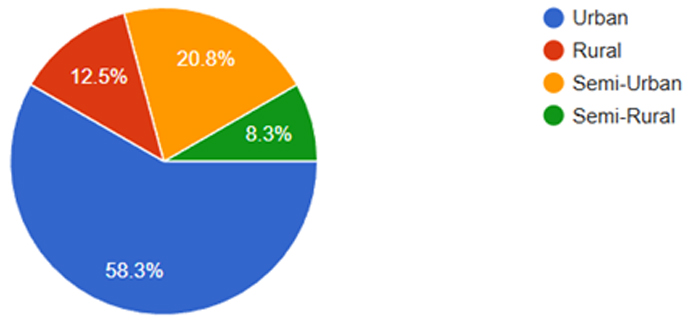
Fig. 1
The 58.3 % Participants Are From The Urban Region, It Indicates The Engagement Of Subject And Awareness Regarding Automobile Industry And Environmental Aspects Related To This. Then, 20.8% Belongs From Semi-Urban Region.
- Age Group
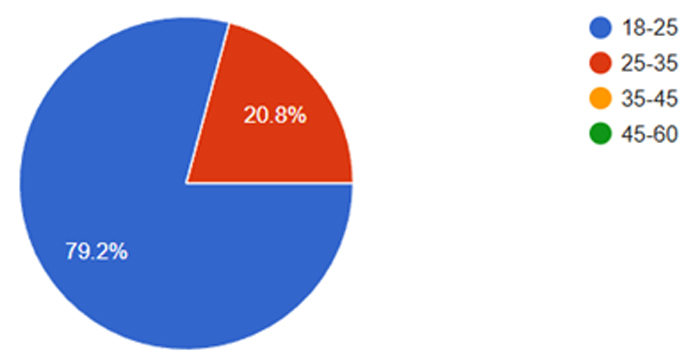
Fig. 2
Age Group (In Years)
18-25- 79.2%
25-35-20.8%
The largest group of respondents, 79.2%, falls within the 18-25 age bracket, showcasing strong interest and awareness among younger individuals. This age group is more likely to engage with sustainability-focused advertisements due to their progressive mindset and interest in eco-friendly solutions. The remaining 20.8% belong to the 25-35 age group, indicating that environmental messaging resonates with slightly older individuals as well, who might prioritize sustainability due to personal and social responsibilities
- How Important Is Sustainability To You When Considering Purchasing A Vehicle?
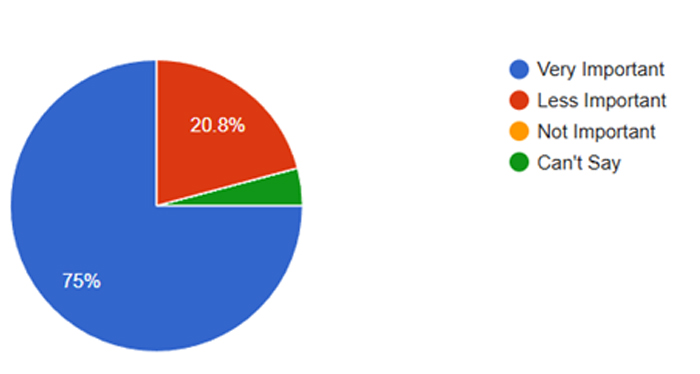
Very Important- 75%
Less Important- 20.8%
Can’t Say- 4.2%
- A significant 75% of participants consider sustainability very important when choosing a vehicle. This demonstrates a growing preference for eco-friendly practices among automobile consumers.
- However, 20.8% rate it as less important, and 4.2% remain undecided, indicating the need for more impactful awareness campaigns to target this segment.
- How Often Do You Notice Environmental Messages In Advertisements For Electric Vehicles And Cars?
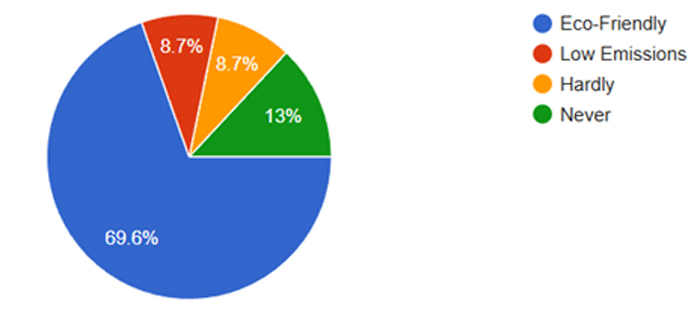
Eco- Friendly- 69.6%
Low-Emissions- 8.7%
Hardly- 8.7%
Never- 13%
Messages focusing on eco-friendliness resonate most, with 69.6% of participants noticing them in advertisements. However, 13% reported never noticing such messages, pointing to the need for improved visibility and clarity.
- Which Of The Following Environmental Claims Would Make You More Likely To Purchase A Vehicle?
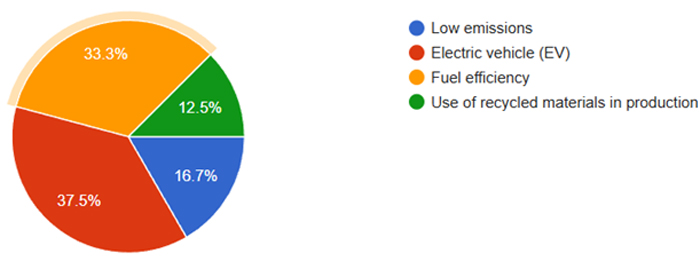
Low Emissions- 16.7%
Electric Vehicle- 37.5%
Fuel Efficiency- 33.3%
Use Of Recycled Materials In Production- 12.5%
Electric vehicles (37.5%) and fuel efficiency (33.3%) were the top claims that attracted consumer interest. Claims about low emissions (16.7%) and the use of recycled materials (12.5%) showed potential but require stronger emphasis in marketing efforts.
- Has Environmental Campaigns Ever Influenced Your Decision To Buy A Specific Automobile Brand Or Particular Model?
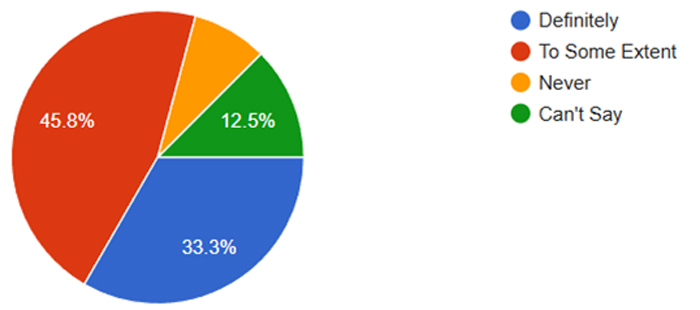
Definitely- 33.3%
To Some Extent- 45.8%
Never-
Can’t Say- 12.5%
Approximately 33.3% of participants reported being strongly influenced by environmental campaigns in their purchase decisions, while 45.8% were influenced to some extent. This shows that advertisements play a substantial role but require deeper resonance to convert potential buyers.
- Which Factor Most Influences Your Decision Of Purchasing An Electric Vehicle?
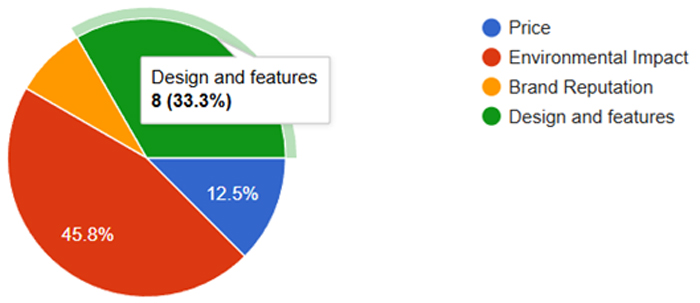
Price- 12.5%
Environmental Impact- 45.8%
Brand Reputation-
Design and Features- 33.3%
Environmental impact (45.8%) emerged as the primary driver for purchasing electric vehicles, followed by design and features (33.3%) and price (12.5%). This reflects the importance of combining sustainability with aesthetics and affordability.
- Do You Think Automobile Companies Are Making Enough Efforts To Deliver Eco-Friendly Alternatives?
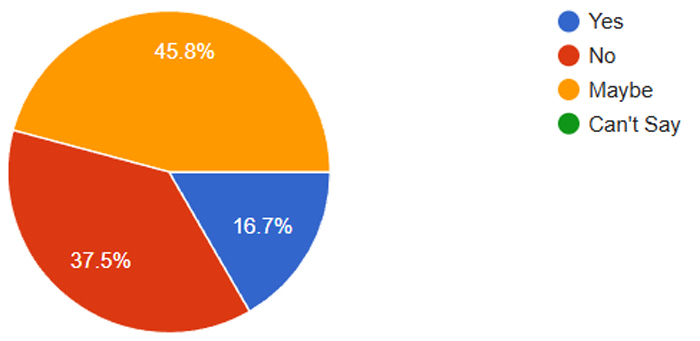
Yes- 16.7%
No- 37.5%
Maybe- 45.8%
Can’t Say-
Only 16.7% of respondents believe companies are making sufficient efforts to provide eco-friendly alternatives, while 37.5% disagree. This reveals a gap in consumer perception and the need for companies to communicate their sustainability initiatives clearly.
- Would You Consider Switching To A More Environmentally Sustainable Brand Even If It Meant Changing Your Usual Preferences?
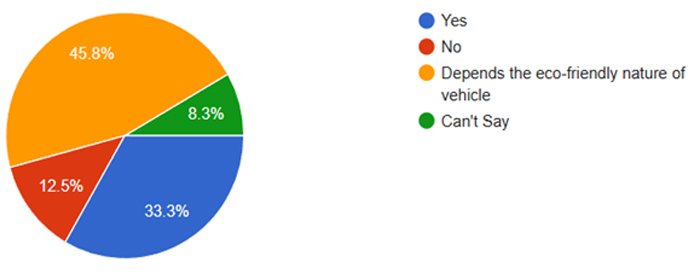
Yes- 33.3%
No- 12.5%
Depends the Eco-Friendly Nature of Vehicles- 45.8%
Can’t Say- 8.3%
About 33.3% are ready to switch to eco-friendly brands, with 45.8% considering it if the vehicles meet their expectations. This reflects openness among consumers but highlights the need for brands to deliver on promises.
- Do You Think That Current Environmental Campaigns In The Automobile Industry Are Clear And Transparent?
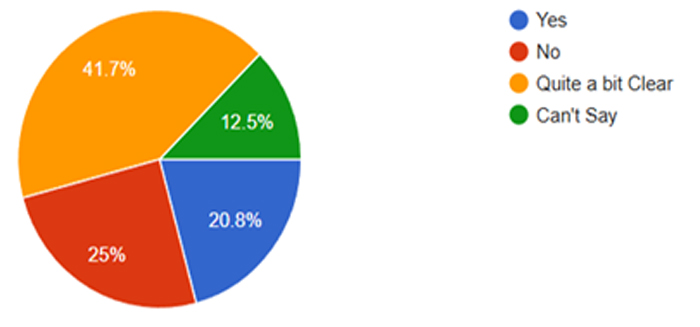
Yes- 20.8%
No- 25%
Quite A Bit Clear- 41.7%
Can’t Say- 12.5%
Responses indicate varied perceptions of environmental campaigns in the automobile industry. While 41.7% find the campaigns “quite a bit clear,” only 20.8% fully agree they are clear and transparent, suggesting that communication is moderately effective but not entirely convincing. A notable 25% believe these campaigns lack transparency, highlighting skepticism toward brands’ environmental claims. Meanwhile, 12.5% are undecided, reflecting either limited exposure or ineffective messaging.
- In Your Opinion, Which Of The Following Would Have The Most Impact On Promoting Sustainability In The Automobile Industry?
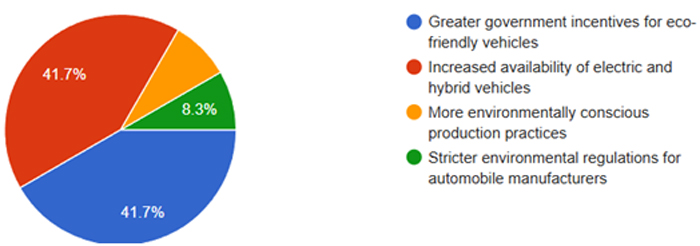
Greater Government Incentives For Eco-Friendly Vehicles- 41.7%
Increased Availability OfElectrnic And Hybrid Vehicles- 41.7%
More Environmentally Conscious Production Practices-
Strict Environmental Regulations For Automobile Manufacturers- 8.3%
FINDING & RESULTS
The study revealed that while environmental campaigns are moderately effective in creating awareness, they fall short in building complete trust. Approximately 41.7% of respondents found these campaigns “quite clear,” but only 20.8% felt they were entirely transparent. This reflects a significant gap between the messaging delivered and consumer expectations.
Sustainability is becoming a priority for most vehicle buyers, with 75% of participants rating it as “very important.” However, many remain skeptical about the genuineness of environmental claims, with 25% believing campaigns lack transparency. Electric vehicles (EVs) and fuel-efficient models were the most appealing aspects of advertisements, but lesser-known features, such as using recycled materials in production, failed to make a significant impact.
Price sensitivity and doubts about companies’ efforts toward eco-friendly alternatives emerged as significant barriers. Only 16.7% of respondents believed automakers were doing enough, while 37.5% disagreed. Furthermore, while many consumers (79.1%) are open to switching to sustainable brands, their willingness often depends on factors like affordability and the tangible benefits of eco-friendly vehicles.Key findings include:
Clarity and Impact of Campaigns:
- Around 41.7% of respondents found campaigns “quite clear,” but only 20.8% agreed they were entirely clear and transparent. This indicates partial effectiveness in communication.
- A significant 25% viewed campaigns as lacking transparency, reflecting skepticism about the authenticity of claims.
Consumer Preferences:
- Sustainability was a priority for 75% of respondents when choosing a vehicle, demonstrating the growing awareness of eco-friendly options.
- Electric vehicles (37.5%) and fuel-efficient models (33.3%) were the most attractive environmental claims, while the use of recycled materials (12.5%) was less impactful, suggesting the need for stronger messaging on less-known sustainable practices.
Barriers to Adoption:
- Only 16.7% of respondents felt automobile companies were making sufficient efforts toward eco-friendly alternatives, while 37.5% disagreed.
- High price sensitivity (12.5%) and limited trust in campaigns suggest that affordability and credibility remain challenges.
Conclusion
The research paper “The Role of Green Advertising to Promote Automobile Industry” underscores the growing importance of sustainability in shaping consumer behavior within the automobile sector. It reveals that while television remains a dominant medium for spreading environmental awareness due to its emotional and visual appeal, inconsistencies in messaging, lack of transparency, and limited relatability hinder its full potential.
The findings highlight that younger consumers, particularly those aged 18–25, are the most responsive to sustainability-focused advertisements. This demographic is characterized by a progressive mindset, digital literacy, and a strong inclination to engage with eco-friendly solutions. However, skepticism persists due to the lack of verifiable data and clear, transparent messaging. Many campaigns rely on vague claims without offering concrete evidence or relevant, relatable examples, which diminishes their credibility and overall effectiveness
Although 75% of respondents consider sustainability an important factor when choosing vehicles, barriers such as price sensitivity, lack of infrastructure awareness, and doubts about the authenticity of environmental claims deter adoption. Moreover, while consumers show interest in switching to eco-friendly brands, their decisions are often conditional on affordability, accessibility, and trust in the brand’s commitment to sustainability.
To bridge the gap between awareness and action, automobile companies must focus on enhancing the transparency and authenticity of their environmental messaging. Clear, relatable, and data-driven campaigns can address consumer skepticism and foster trust. Collaborating with government initiatives, simplifying technical jargon, and emphasizing practical benefits are crucial steps toward making sustainability more accessible and appealing.
In conclusion, the research demonstrates that environmental messaging holds immense potential to drive behavioral change and promote eco-friendly practices in the automobile industry. However, realizing this potential requires a concerted effort to align messaging with consumer expectations, ensuring that it is not only informative but also credible, relatable, and actionable. By addressing these challenges, the automobile industry can play a pivotal role in advancing sustainability and fostering a greener future.
Bibliography
- Valentini, C., &Kruckeberg, D. (2018). “Walking the environmental responsibility talk” in the automobile industry: An ethics case study of the Volkswagen environmental scandal. Corporate Communications: An International Journal, 23(1). https://doi.org/10.1108/CCIJ-04-2018-0045
- Vatsa, Madhuranjan & Singh, Satendar & Chaudhary, (2021). Study of green advertisements in indian automobile sector for environmental sustainability. IOP Conference Series: Materials Science and Engineering. 1091. 012015. 10.1088/1757-899X/1091/1/012015. https://www.researchgate.net/publication/350079267_Study_of_green_advertisements_in_indian_automobile_sector_for_environmental_sustainability/citation/download
- Gottumukkala, M., Kalvakolanu, N. S., Bobba, V., & Bathina, S. (2024).
Sustainable Green Marketing Practices of the Automotive Industry in India: A Thematic Analysis of Key Players. Library Progress (International), 44(3), 17813-17823. Maruti Suzuki’s ‘It’s Unbelievable. It’s Strong Hybrid’ Campaign https://bpasjournals.com/library-science/index.php/journal/article/view/1151 - Tata Motors’ EV Incentives
Passionate in Marketing. (2023, June 27).Never been to EVergreen – A campaign by Tata Motors.https://www.passionateinmarketing.com/never-been-to-evergreen-a-campaign-by-tata-motors/ - Hyundai’s ‘Progress for Humanity’ Campaign Hyundai Motor India. (n.d.). Progress for Humanity. April 15, 2025, from https://www.hyundai.com/in/en/hyundai-story/progress-for-humanity
- FAME India Scheme’s Role in Promoting Cleaner Technologies Chambers and Partners. (2023).Evaluating FAME II: Insights and the Road Ahead.
Retrieved from https://chambers.com/articles/evaluating-fame-ii-insights-and-road-ahead - Customs Duty Exemptions for Lithium-Ion Cell Manufacturing Press Information Bureau, Government of India. (2023, February 1). Union Budget 2023-24: Customs duty exemption extended for lithium-ion cellmanufacturing.https://pib.gov.in/PressReleseDetailm.aspx?PRID=1907698&utm=®=3&lang=1
- GST Reductions on EVs and Charging Infrastructure Press Information Bureau, Government of India. (2022, January 5).GST Council reduces rates on EVs and charging equipment.
https://pib.gov.in/PressReleasePage.aspx?PRID=1797676 - Import Duty Reductions for Automakers Investing in Domestic EV Production Autocar India. (2024, March 15).New EV policy to reduce import duty to 15 percent.
https://www.autocarindia.com/industry/new-ev-policy-to-reduce-import-duty-to-15%C2%A0percent-434630 - Mercom India. (2024).Electric Vehicle Sales Clock 27% Yearly Growth in 2024, Reach 1.9 Million Units https://www.mercomindia.com/electric-vehicle-sales-2023
- (2024, April 5).India EV sales to rise 66% this year after nearly doubling in 2023, report says.
https://www.reuters.com/business/autos-transportation/india-ev-sales-rise-66-this-year-after-nearly-doubling-2023-report-says-2024-04-05/ - (2020, February 6).Maruti Suzuki launches ‘People Technology’ campaign. https://www.exchange4media.com/advertising-news/maruti-suzuki-launches-people-technology-campaign-110913.html​:contentReference[oaicite:1]{index=1}
- Business Model Analyst. (2025, March 28).Maruti Suzuki Marketing Strategy. https://businessmodelanalyst.com/maruti-suzuki-marketing-strategy/​:contentReference[oaicite:2]{index=2}
- Valentini, C., &Kruckeberg, D. (2018). “Walking the environmental responsibility talk” in the automobile industry: An ethics case study of the Volkswagen environmental scandal. Corporate Communications: An International Journal, 23(1). https://doi.org/10.1108/CCIJ-04-2018-0045
- Metropolia University of Applied Sciences. (2020). Automotive industry adapting to going green? Bachelor’s Thesis.
- Yaghi,S.(2024).Theeffectofgreenadvertisingonconsumers’environmental attitudes:Astudyoftheautomotiveindustry.InKhamis,R.,&Buallay,A.(Eds.), AI in business: Opportunities and limitations (Studies in Systems, Decision and Control, vol. 516). Springer, Cham. https://doi.org/10.1007/978-3-031-49544-1_20
- Tillu, P. G., Digalwar, A. K., Singh, S. R., &Reosekar, R. S. (2024). Towards sustainable automobile ecosystem in India: Integrated analysis of technical, economic, and ESG dimensions. Cleaner Environmental Systems, 16, Article
[1]Faculty, Department of Cinema Studies, MCU Bhopal
[2]Student, Department of Cinema Studies, MCU Bhopal
